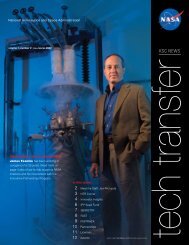2006-2007 - Kennedy Space Center Technology Transfer Office
2006-2007 - Kennedy Space Center Technology Transfer Office
2006-2007 - Kennedy Space Center Technology Transfer Office
- No tags were found...
You also want an ePaper? Increase the reach of your titles
YUMPU automatically turns print PDFs into web optimized ePapers that Google loves.
Countermeasure for Radiation Protection and RepairExposure to ionizing radiation during long-duration space missions is expected toEnergy-Efficient cause short-term illness and increase long-term risk of cancer for astronauts. Radiationinducedfree radicals overload the antioxidant defense mechanisms and lead to cellularLighting Systemsdamage at the membrane, enzyme, and chromosome levels. A large number ofradioprotective agents were screened, but most had significant side effects. But there is increasingevidence that significant radioprotective benefit is achieved by increasing the dietary intake of foodswith high antioxidant potential.Early plant-growing systems for space missions will be limited in both size and volume to minimizepower and mass requirements. These systems will be well suited to producing plants containinghigh concentrations of bioprotective antioxidants. This project explored whether the productionof bioprotective compounds could be increased by altering the lighting system, without increasingthe space or power requirements for production, and evaluated the effects of environmentalconditions (light quantity, light quality, and carbon dioxide [CO 2] concentration) on the productionof bioprotective compounds in lettuce, which provide a biological countermeasure for radiationexposure.The specific deliverables were to• develop a database of bioprotectant compounds in plants that are suitable for use on longdurationspace missions,• develop protocols for maintaining and increasing bioprotectant production under lightemittingdiodes (LEDs),• recommend lighting requirements to produce dietary countermeasures of radiation, and• publish results in the Journal of the American Society for Horticultural Science.Red leaf lettuce contains relatively high concentrations of bioactive pigments known as anthocyanins.These pigments, as well as other antioxidant molecules, have radioprotective properties. To determineif the concentration of these compounds could be increased, several red leaf lettuce cultivars weregrown under either fluorescent lamps or LEDs at 300 µmol m –2 s –1 of photosynthetically activeradiation (PAR) of light intensity, 1,200 µmol mol –1 CO 2, 23 °C, and an 18-hr light/6-hr darkphotoperiod in controlled-environment chambers. The LED treatments were selected to providedifferent amounts of red (640-nm), blue (440-nm), green (530-nm), and far red (730-nm) light inthe spectra. Total anthocyanin content and the oxygen radical absorbance capacity (ORAC) of thetissue were measured at harvest. The results were comparedwith effects of light intensity under fluorescent lamps from100 to 450 µmol m –2 s –1 PAR and CO 2concentrations of 400,1,200, and 3,000 µmol mol –1 . Bioprotectant concentrationof red lettuce grown under red (640-nm) and blue (440-nm)light was comparable to plants grown under fluorescent lamps.High-output LED arrays provide the capability to definespectra to increase the concentration of radioprotectivecompounds.The source of light had a dramatic effect on both plantgrowth and production of radioprotective compounds. LEDsproduced 50 percent more bioprotectant content per plant atthe same light level than did conventional fluorescent lamps.The use of LEDs containing blue (440-nm) light in particularappeared to activate the pathways leading to increasedconcentration of bioprotective compounds in leaf tissue.LEDs provided a number of indirect effects that increasedthe bioprotective content. LEDs also allowed the ability to90 Biological Sciences













